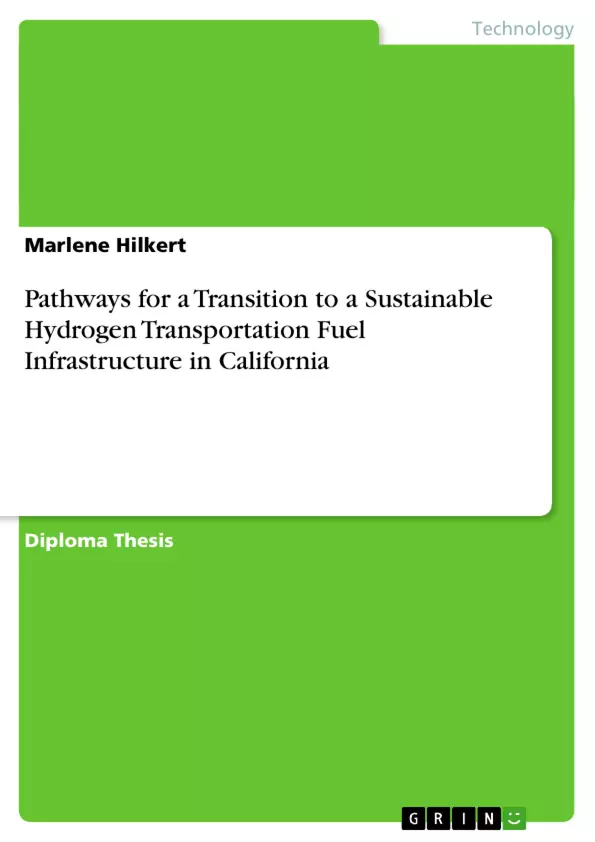As society enters the 21st century, there is a growing awareness of the burdens being placed on the planet, as its ability to keep up with the demands of modern society are strained. One of the major contributors to this burden happens to be a main resource required for sustained development. Energy has always been, and will always be a necessary resource for existence. Since the industrial revolution, fossil fuels such as coal and oil have been the main-stay fuel to accommodate society's appetite. As the demand for this resource increases, the climatic and socio-economic costs of this fuel become more acute, and it is well documented that the supply of this fuel is not endless. One of the major consumers of this fuel, as a society, is the transportation sector. The processes in place which take it from the ground, to its combustion as a fuel, are some of the main culprits which adversely affect the planet. This thesis explores the issues associated with the introduction of another energy resource – Hydrogen – as a replacement fuel for the transportation industry. It is argued that for the transportation sector, Hydrogen offers the most promising alternative as a fuel. Making Hydrogen readily available and affordable through the retail infrastructure is of paramount importance, if its widespread use is to be achieved. The logistics of this are explored, and it is believed that the introduction of small Hydrogen fuelers at existing retail outlets, is the preferred method to instantiate the transition in the short to medium term. Those fueling stations can utilize grid electricity to produce Hydrogen by the means of water electrolysis, or take advantage of the existing Natural Gas distribution infrastructure to produce Hydrogen via steam reformation. This thesis examines the Well-to-Wheels impacts and economic feasibility of those options and compares them to existing vehicle and fuel technologies. The state of California was chosen as a target market due to its high automobile density, the resulting pollution issues, and its clear mandate on promoting alternative energy sources.
Inhaltsverzeichnis (Table of Contents)
- I Introduction
- 1. Summary of the work.
- 2. Environmental, economic, and political challenges associated with the use of fossil fuels, especially oil.
- 2.1 Environmental and Social Problems with Fossil Fuels
- 2.1.1 Environmental pollution - Oil spills and discharges
- 2.1.2 Environmental pollution – Local Emissions.
- 2.1.3 Environmental pollution – Global Climate Change
- 2.2 Exploitation of non-renewable resources
- 2.3 Economic dependence on finite resources.
- 3. Facts about California
- II. Technical background.
- 4. Fuel Options for Transportation
- 5. Alternative means of transportation
- 6. Hydrogen and Transportation....
- 6.1 Physical and Chemical Properties of Hydrogen.
- 6.2 Use of hydrogen
- 6.2.1 Contemporary use of hydrogen
- 6.2.2 Fuel Cells...
- 6.2.3 Safety.
- 6.3 Manufacture of Hydrogen
- 6.5 Transportation of Hydrogen
- 6.6 Retail Infrastructure for Hydrogen
- 6.7 The Hydrogen Economy..
- 6.8 Selected Hydrogen Programs and Cooperations.
- 7. Electrolysis of Water.
- 7.2 Opportunities and Problems of Hydrogen Production with Electrolysis
- 7.3 Electrolyzer Appliances....
- 7.4 Feedstocks for Electricity Generation .
- III. Analysis of Different Hydrogen Production Pathways.
- 8. Criteria for the Analysis
- 9. Different Fuel and Vehicle Scenarios.
- 10. The GREET 1.6 Model....
- 11. GREET Input Assumptions.
- 12. GREET Results
- 12.1 Energy Consumption..
- 12.2 CO2 and GHG Emissions
- 13 Hydrogen Production Costs....
- IV. Policy Options .
- 14 Policy Instruments .
- 15 Policy Instruments in Place
Zielsetzung und Themenschwerpunkte (Objectives and Key Themes)
This thesis investigates the feasibility of transitioning California's transportation sector to a hydrogen fuel infrastructure. It examines the environmental, economic, and political challenges associated with the use of fossil fuels, particularly oil, and explores hydrogen as a promising alternative fuel. The study analyzes the technical aspects of hydrogen production, storage, distribution, and utilization, including the potential for water electrolysis and steam reformation.
- Environmental impact of fossil fuels and the need for sustainable alternatives
- Technical feasibility and economic viability of hydrogen as a transportation fuel
- Analysis of different hydrogen production pathways, including water electrolysis and steam reformation
- Evaluation of policy options and instruments to facilitate the transition to a hydrogen economy
- Assessment of the potential impacts and benefits of a hydrogen transportation infrastructure in California
Zusammenfassung der Kapitel (Chapter Summaries)
- I Introduction: This chapter introduces the thesis and discusses the challenges posed by fossil fuels, highlighting the need for sustainable alternatives. The potential of hydrogen as a transportation fuel is emphasized, and the importance of developing a robust retail infrastructure for its widespread adoption is underscored.
- II Technical Background: This section provides a comprehensive overview of the technical aspects of hydrogen as a fuel, covering its physical and chemical properties, existing and potential applications, and safety considerations. It also explores the various methods of hydrogen production, including electrolysis and steam reformation.
- III Analysis of Different Hydrogen Production Pathways: This chapter presents a detailed analysis of different hydrogen production pathways, utilizing the GREET 1.6 model. The study compares the energy consumption, CO2 emissions, and economic feasibility of different scenarios, including those involving electricity generation from renewable sources and those relying on existing natural gas infrastructure.
- IV Policy Options: This section delves into policy options and instruments for promoting the transition to a hydrogen economy. It examines existing policy instruments and proposes additional measures to encourage the adoption of hydrogen vehicles and infrastructure.
Schlüsselwörter (Keywords)
This thesis focuses on the transition to a sustainable hydrogen transportation fuel infrastructure, exploring its technical feasibility, economic viability, and policy implications. Key terms include hydrogen production, water electrolysis, steam reformation, fuel cells, well-to-wheels analysis, energy consumption, CO2 emissions, and policy instruments.
- Arbeit zitieren
- Marlene Hilkert (Autor:in), 2003, Pathways for a Transition to a Sustainable Hydrogen Transportation Fuel Infrastructure in California, München, GRIN Verlag, https://www.hausarbeiten.de/document/22039


